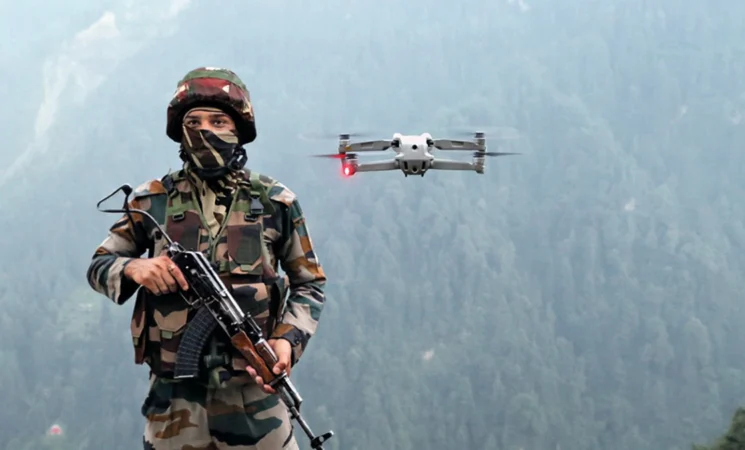19 October 2025, NIICE Commentaries 11857
Avneesh Kumar Singh
On June 2, 2025, Ukraine launches a series of attacks on four different locations inside Russia, using smuggled drones deep inside Russia, which destroyed around 40 Russian warplanes. The drones used in the attack were placed near the target area. This attack raises global security concerns about the potential threat of other state and non-state actors adopting this method worldwide. The smuggled drone attack tactics can be adopted by terrorist groups. Various terrorist organisations in the world are using various drones for attacks and logistics support.
India is more vulnerable to such type of attacks due to the various internal and external factors. India shares land borders with several countries, out of which some country has an open border with India. The open border is used for smuggling narcotics, contraband, counterfeit money and various illegal items. Illegal migrants also enter India through these borders. With the diverse geographical and cultural factors, various part of India faces different internal security challenges. India faces the issue of insurgency in the northeastern parts, central India has a security challenge of Naxalism and terrorism, which affects all over India, but has a security threat in the western border state.
India also encountered various incidents where drones were used for smuggling and disrupting internal security. Most of these incidents happened on the western border, which India shares with Pakistan, which is a hostile neighbour. Pakistan uses drones to smuggle arms and ammunition, narcotics substances and counterfeit money. This smuggling activity was conducted through the border region of Panjab, Rajasthan and Jammu, which includes border points at Fazilka, Firozpur, Taran, and Pathankot. On 27 June 2021, two improvised explosive devices (IEDs) were dropped at the Air Force Station in Jammu. One of the IEDs was dropped on the roof of the building, and another was dropped in the open area by using low-flying drones. The drone was launched from the Pakistan side. During the Manipur violence in 2024, a modified drone was used to attack, resulting in the death of two people and six others were injured. The bomb attack happened in the Kadangband and Koutruk villages of Manipur.
India's armed forces have deployed the drone for border security through surveillance, Intelligence and reconnaissance. Indian forces have shown drone warfare capability in Operation Sindoor, where various Indian and foreign systems were used against Pakistan. In July 2025, India carries out a drone attack in Myanmar. The attack targeted four camps belonging to ULFA-I, a joint camp of ULFA-I and People Liberation Army (PLA), Revolutionary People’s Front (RPF), Meitei rebel group. Drones are also used for disaster management, search and rescue operations and various humanitarian missions.
India has developed various countermeasures to counter drones, including an anti-drone gun, radar system, radio frequency jammers and laser system. India has also introduced a low-cost and effective method to counter drones used for illegal activity across the border. The Border Security Force (BSF) of India and the Telangana police have started training eagles and falcons to counter the drones. India's armed forces have inducted a specific drone training centre for soldiers to counter drone warfare. Establishment of training institutions includes the Indian Military Academy (Dehradun), Infantry School (Mhow), and Officers Training Academy (Chennai). Border Security Forces (BSF) has opened India's ever drone warfare school to train the army soldiers at the Officers Training Academy in Tekanpur, near Gwalior, Madhya Pradesh. Looking towards advancement in drone technology in the border forces, BSF also signed MoUs with various Indian Institute of Technology (IITs) and government research organisations.
Directorate General of Civil Aviation (DGCA), an agency of the Ministry of Civil Aviation of India, has set rules and regulations for operating the drone, issuing of license to fly a drone and registering of drone. This was done to regulate the misuse of drones so that drones cannot be used for any illegal activity. A drone can fly in the specific fly zone, “Green Zone” where the drone can fly up to a height of 400 feet or 120 metres, “Yellow Zone” where the drone can fly up to a height of 200 feet or 60 metres, “Red Zone” which is a no-fly zone.
India has seen a few incidents where drones are used to attack or harm civilians. Drones are used in other illegal activities that are a threat to the national security of India. The potential threat of a drone attack cannot be denied in disturbing India's internal security. With the use of a drone, a precise attack can be carried out near airports, government or high-value targets. At the same time, an attack from a drone needs a warhead, which is mounted on a commercial or nano drone. Attacking with a drone is a low-cost method and poses a growing challenge. There is a chance that drones can be used by various state-sponsored terrorist organisations or insurgent groups. The threat to internal security is not limited to an attack using a drone; it also depends on a cyber-attack on the current system, using it as a weapon to disrupt air traffic.
A drone is an emerging technology with dual-use capabilities that can be used for constructive or destructive purposes. India should focus on a multi-pronged strategy to counter the drone threat. India must develop and deploy robust anti-drone infrastructure. India should create a system to manage and track drone traffic. International cooperation is also required on drone regulation and information sharing. Regulation on Controlling the Sale and Import of High-Capability Drones. India must invest in the infrastructure of cyber and single intelligence to detect drone control systems.
Avneesh Kumar Singh is a Research Scholar at Hemvati Nandan Bahuguna Garhwal University, Srinagar (Garhwal), Uttarakhand, India.

